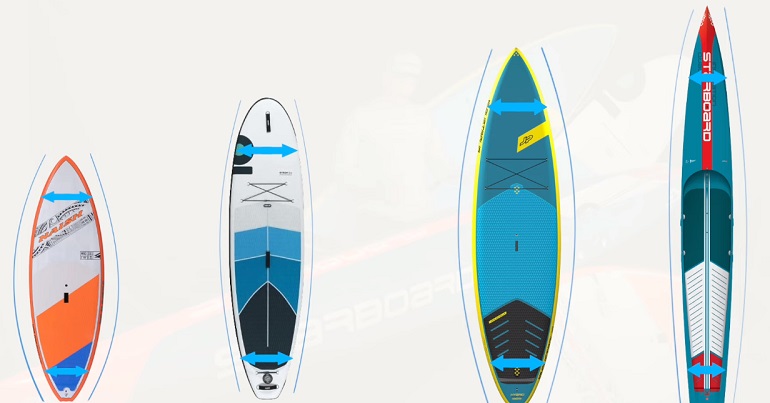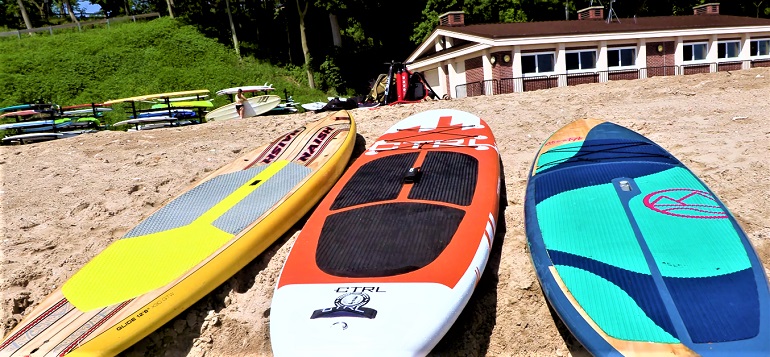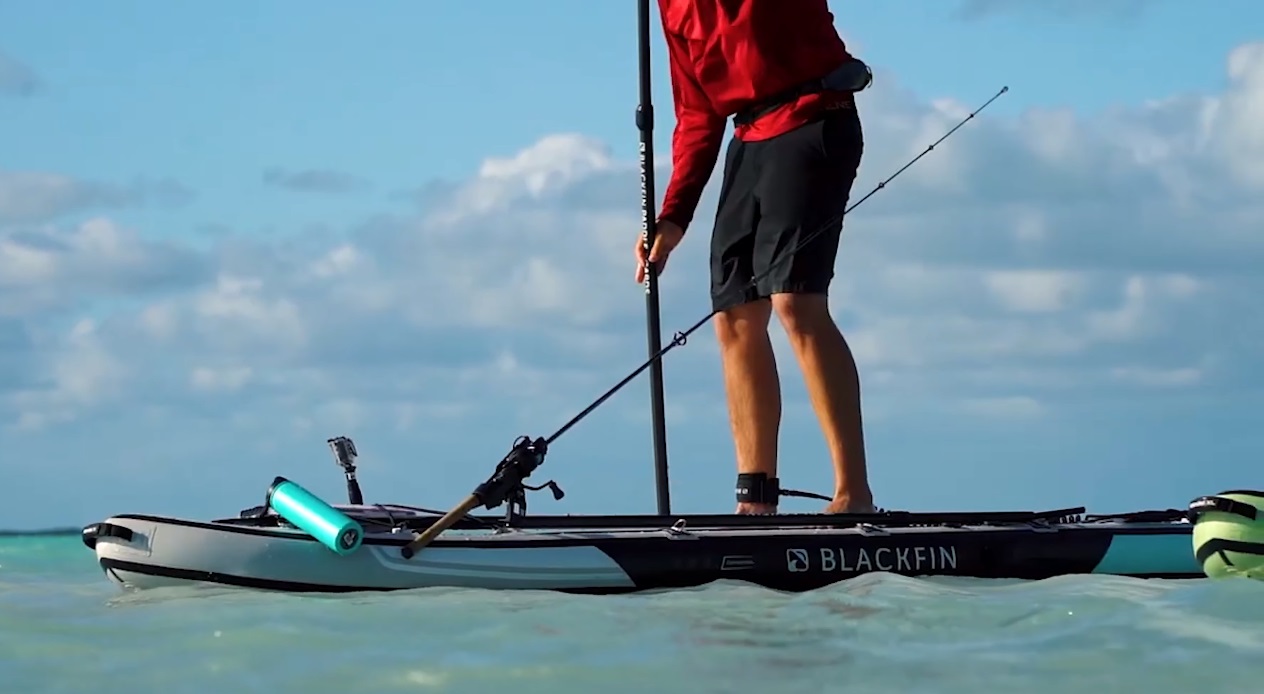Paddle boarders are a common sight on my local beaches in British Columbia. This form of aquatic exercise has become increasingly popular within the past few years. Personally, I have only been paddle boarding a few times.
Honestly, I prefer to jump straight into the water or get on board a trusty kayak.
That said, I appreciate the fact that paddle boarding is great for your core, and it’s yet another excuse to get out and enjoy the sun.
Before you get out on your paddle board, you’re going to have to answer one very simple question:
“What size paddle board do I need?”
This question might be a little trickier than you realize.
Fortunately, this guide should tell you everything you need to know about choosing the right size paddle board.
Dimensions You Must Know to Find the Right Size
There is a huge variety of paddle boards available on the market; from an all-around paddle board to inflatable boards, race boards, SUP touring boards, longer paddle boards, and paddle boards for SUP yoga too. First of all, there are a number of dimensions (volume, length, width and thickness) you must be aware of when choosing your first paddle board:

Volume
The volume of your paddle board is typically represented in liters. To find the ideal volume, multiply your total body weight by a ratio of 1.1 to 1.4. It might be a good idea to take into account the gear you’ll be carrying on your paddle board.
A typical paddle board has a volume of between 185 liters to 260 liters. Volume determines the paddle board’s buoyancy. This is the weight capacity a paddle board can float while carrying a certain amount of weight. If it exceeds above the limit, you will have less stability and will have to reduce weight.
Choose a paddle board with very less volume, and you will have less stability and struggle to stay afloat. You may also notice drag and sinking.
Length
The length of your paddle board depends on several other factors. Paddle boards can range from 8 to 14 feet. However, the “sweet spot” for most paddle boards is between 10 and 12 feet.
First of all, you should consider who is using the paddle board. If you’re shopping for a paddle board for your child, you might want to opt for a shorter board with a length of less than 10 feet. Boards specifically designed for kids are generally about 8 feet long.
Medium size paddle boards are good for adults who want an all-around board. These medium size paddle boards are also ideal if you’re planning to use your paddle board for yoga. A Medium size paddle board is about 10 to 12 feet in length.
If you are a particularly tall or heavy individual, you might want to opt for a long board. These boards work well for fast paddling and long touring distances. Long boards are typically about 12 feet long or even longer.
Obviously, there is generally a relationship between volume and length. A longer board will inherently have more volume.
Width
Another important consideration is the width of your SUP board. Paddle boards have widths that range from 25 to 36 inches. Smaller individuals may want to opt for narrower boards. In contrast, larger individuals may want to opt for wider boards.
That being said, wider boards are also useful if you plan to carry lots of gear with you. The important thing to realize is that narrower boards are also more maneuverable, which may be more enjoyable for some users.
A wider board offers enough stability for yoga. In addition, more advanced paddlers may feel more comfortable using narrower boards, whereas beginners may feel more comfortable using wider boards.
Thickness
Finally, you should consider the board thickness of your SUP board when making your final decision. A thicker board obviously has extra volume.
On the other hand, a skinny board will typically offer greater speeds across flat water on lakes and calm oceans. The goal is to get the most amount of performance while still having enough volume to offer solid buoyancy.
What Size Paddle Board Do I Need for My Weight and Height?
As previously mentioned, you can calculate the ideal volume for your SUP board by multiplying your weight by a ratio of between 1.1 and 1.4. Beginners should multiply their weight by either 1.1 or 1.2.
Remember to factor in the amount of gear you will be carrying on your board. You might also want to factor in the weight of a dog or small child that will be riding with you on your SUP board.

You might also want to bring some fishing gear on your journey. Of course, you might want to bring some water and food for longer distances.
The general rule for height is as follows:
Take your height and add between 9 to 10 inches. This will give you the ideal size paddle SUP board. For example, if you are 6 foot 2, you might need a paddle board that is up to 7 feet in length.
Of course, these considerations may vary depending on your specific ability level and the type of activities you plan to engage in on your paddle board.
You should also consider how you’re planning to use your standard paddle board.
There are specific types of SUP boards built for river and whitewater applications. These are known as “river runners” or “river surfers.” These SUP boards are usually a little longer than typical stand-up paddle boards – giving you more speed. They may also have fin systems for additional stability.
As previously mentioned, the paddle board you need if you’re planning to use it primarily for yoga should be wider and more stable.
If you’re planning to use your stand-up paddle board in the open ocean, consider reaching for epoxy-hard paddle boards. This is a solid choice because of the rigidity of epoxy-hard paddle boards.
If you’re planning to use your paddle board mostly on lakes, you might get away with using a slightly thinner board because of the lack of waves. Board thickness is not the most important thing because you won’t feel unstable between the waves.
Beginner Paddle Boards
If you’re getting into paddle boarding as a beginner, consider the following chart:

Intermediate to Advanced Paddle Boards
If you’re looking for an intermediate to advanced paddle board, consider the following chart:

The Maximum Weight Capacity
Here’s the thing:
You shouldn’t avoid going paddle boarding just because you weigh more than the average person.
All you need to do is choose a paddle board that offers you enough volume to support your weight.
The good news is that there are paddle boards out there that can support up to 500 pounds of weight. This should be more than enough to support you and your gear – even if you weigh more than the average person.
Pay close attention to the volume of your paddle board, as the last thing you need is to start sinking once you get out over open water!
What About Inflatable Paddle Boards?
The Best inflatable SUP paddle boards offer several benefits that you should be aware of if you’re choosing a solid first paddle board for your first adventure.

Firstly, these inflatable SUP boards typically offer a higher volume and buoyancy rating. This means that they’re capable of supporting much more weight than a non-inflatable paddle board or a hard paddle board (hard SUPs).
Just keep in mind that more experienced paddlers prefer the thinner, more maneuverable qualities of a non-inflatable paddle board.
On the other hand, inflatable paddle boards are easy to pack away and transport – especially if you’re dealing with limited trunk space.
Time to Go Paddle Boarding!
Now you know the answer to the question:
“What size paddle board do I need?”
The only thing that remains is to get out there and start paddle boarding.
Personally, I think paddle boards are a solid choice for anyone who wants to get some exercise and fresh air.
Remember, choosing the right size SUP is just the beginning.
There’s a lifetime of adventures waiting for you after you choose your new board – whether you’re interested in flatwater paddling, SUP fishing, all-around paddling, or straight tracking.
Or maybe you’re interested in inflatable paddle boards (or inflatable SUPs). You can check out the differences between inflatable and solid boards to make the perfect choice for yourself.
Once you’ve chosen the ideal length, the right board, and the best SUP thickness, you can expect amazing experiences as you use your best paddle board for its intended use:
Having fun!